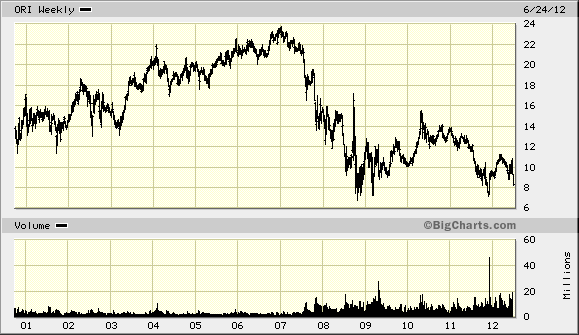 A reader sent me this link of a great blog on forensic accounting. There are lessons here from morality, survival instincts, to overplaying a hand, to accounting shenanigans and to my loss of yet another value investing icon–Prem Watsa. Did he engage in a sham transaction to save his company from collapse during 2003? See for yourself.
A reader sent me this link of a great blog on forensic accounting. There are lessons here from morality, survival instincts, to overplaying a hand, to accounting shenanigans and to my loss of yet another value investing icon–Prem Watsa. Did he engage in a sham transaction to save his company from collapse during 2003? See for yourself.
The Financial Investigator
http://www.thefinancialinvestigator.com/?p=702&utm_source=rss&utm_medium=rss&utm_campaign=the-miracle-on-wellington-street
The dark side of a well known value investor
Fairfax’s purchase of 4.3 million shares of Stamford, Ct.-based Odyssey Re, increasing its stake to just over 80% from 74%, was the most consequential transaction in Watsa’s career. Though few understood it at the time, the March 2003 deal allowed the then money-losing Fairfax to take advantage of a little understood maneuver called “tax consolidation,” enabling Fairfax to claim (and receive) the profitable Odyssey Re’s tax payments.
Between 2003 and 2006, these payments amounted to more than $400 million.
That cash stream helped Fairfax avoid a brutal accounting charge that might have proven its undoing and boost its share price over several months to almost $250 from a January 2003 low of $57.
Ecstatic investors and nine-figure wealth was only the half of it for Fairfax and Watsa: The company launched a furious legal campaign in 2006 against a group of short-sellers who had (in some instances) quite publicly bet on the insurer’s demise, a campaign now entering its sixth year. Though developments and rulings in the case have recently been sharply unfavorable for Fairfax, its opponents have been silenced and their short-sales unprofitably covered. (Lessons here for Short-Sellers and investors in insurance companies)
With the breathing room the cash afforded, Fairfax was able to access the capital markets, allowing it the flexibility to wager more than $340 million on credit default swaps that exploded in value as the credit crisis worsened in 2007 and 2008. The bet paid off brilliantly and Fairfax ultimately reported a $2.1 billion gain, completing a five-year metamorphosis that saw almost $6 billion added to its book value.
Fairfax is now a full fledged cult stock among value investors, and its success led at least one well-known investor to announce his switch from being short to proudly owning the shares (he has since sold the stock.)
The Odyssey Re share purchase was born in the desperation of a looming collapse.
Because of insurance losses from the September 11 attacks, the need to increase reserves and a bad acquisition, Fairfax’s auditors at PWC had concluded that an arcane tax asset then crucial to its balance sheet was going to have to be written down.
Called net operating loss carryovers (NOLs), they represent a company’s accrued operating losses that can be applied against future income to lower the company’s taxable income. Here’s how they work: a company with $500 million in taxable income and a $250 million NOL could apply it to cut the amount of taxable income in half. NOLs are certainly handy but they come with a firm proviso: they have a defined shelf life and can be used only when a company is “More likely than not” to generate the income to offset them, usually within seven years.
In other words, PWC had real doubts Fairfax could generate enough income in the future to warrant keeping the NOLs attributable to its U.S. operations. So in February 2003, the auditors informed the company that as of June 30, they were recommending half of its $795 million worth of U.S. NOLs on the balance sheet–or $348 million–be written down.
To be sure, companies large and small are constantly shifting the value of assets on their balance sheet for dozens of valid reasons.
But this was different. Did Watsa engage in a sham tax transaction?
PWC was demanding a material valuation allowance which would be accounted for as a charge against earnings. The charge would have given Fairfax their second massive annual loss in three years and prompt further share price declines–its market cap was around $1 billion at the time, and had dipped down to about $750 million that January–but where the real trouble lay was in the specter of credit downgrades, both on its corporate debt and its financial strength ratings, a key barometer of its claims paying ability. In early 2003, declining liquidity prompted Standard & Poor’s to reduce Fairfax’s credit ratings even further below investment-grade. Its insurance ratings from A.M. Best were affirmed only after the Odyssey Re deal was complete, a process Ambridge had spent weeks communicating with A.M. Best’s Joyce Sharaf about.
Thus buying the 4.3 million Odyssey Re shares that would take them to 80% ownership and tax consolidation was no longer an option, but a necessity.
There was a hitch, however, as Fairfax didn’t have the cash to spare.
To get around this, Fairfax’s Watsa and his staff, in conjunction with a Bank of America Securities team, came up with a three-step, cashless (oh no!) proposal whose final iteration was this:
1. NMS Cayman Services Ltd., an offshore affiliate of Bank of America Securities, borrowed the 4.3 million shares from 10 different institutions and then re-loaned the stock to Fairfax.
2. In lieu of cash, Fairfax issued a $78 million note to the same BAS affiliate as payment.
3. Fairfax then pledged the newly acquired Odyssey Re shares back to Bank of America Securities as collateral for the notes.
To outsiders, the Odyssey Re note deal was designed to appear like a convertible bond: It bore an interest rate and in March 2005 (two years after the transaction) was exchangeable into Odyssey Re stock, giving the holder–NMS, the Bank of America Securities affiliate–the right to swap back into the shares.
To insiders, including Bank of America’s credit analysis unit and Fairfax’s leadership, there was little doubt that the exchange would be made in two years: The Fairfax bonds carried a below-market interest rate of 3.15% and, according to then CFO Trevor Ambridge, the bonds represented “an inferior risk exposure” for Bank of America. Had Bank of America Securities held the bonds and not exchanged them back into stock, they would have been short 4.3 million, or 33% of the remaining Odyssey Re float, something the firm estimated would have taken 20 months to buy back in the open market and, quite likely, cost their trading desk tens of millions of dollars in losses.
Per Ambridge, in a July 2003 E-mail to a PWC partner, the transaction was structured to secure a block of stock for a limited amount of time for tax consolidation purposes without reducing the public “float,” or shares available for trading. He did not even want the extra 6% worth of Odyssey Re’s earnings included in Fairfax’s income statement since it was inevitable that Bank of America would exercise its exchange privilege and take the shares back in two years.
The transaction’s structure also casts doubt on whether Fairfax’s Odyssey Re maneuvers allow it to claim true ownership of the stock.
Robert Giammarco, a Bank of America Securities banker who helped design the deal, noted in an E-mail to colleagues that one of the transaction’s “disadvantages” was it “Does not provide true economic ownership” of the Odyssey Re stock to Fairfax. [Giammarco would go on to serve a 19-month term as CFO of Odyssey Re before joining Merrill Lynch prior to its purchase by Bank of America Securities in 2008. Fairfax asserted to the New York Times that he recanted his description of the deal in a 2011 deposition.]
Recall that Bank of America Securities did not sell Fairfax the securities, but borrowed the shares and then “sold” them to Fairfax for what both parties understood was to be a defined period; neither party ever exchanged cash as part of the deal because of the anticipated use of the conversion feature. Fairfax did not own them in any broadly understood sense of the word since it was not entitled to profit or loss from the 4.3 million Odyssey Re shares nor could they re-lend (or, in Wall Street parlance, re-hypothecate) them out. The company was also forbidden to sell any of the share block. Put simply, for all the deal’s complexity and hard work, the additional shares gave Fairfax no obvious economic privileges nor exposure to Odyssey Re.
Similarly, in agreeing to compensate Bank of America Securities for all of its hedging costs or losses, Fairfax was engaging in economic behavior entirely outside of market norms for a purchaser of securities. Edward Kleinbard, Third Point Management’s expert witness, noted in his opinion, “No bona fide owner of stock would agree to cover a short-sellers cost of maintaining its open short sale.”
The economic exposure argument is key since it appears there was no way Fairfax could profit from the Odyssey Re deal. If the stock price went up, Bank of America Securities would simply exercise their conversion privilege, without incurring any additional cost. On February 7, 2003, Prem Watsa wrote an E-mail to Sam Mitchell (a friend who would later become an executive with Hamblin Watsa, Fairfax’s investment subsidiary, and a board member of companies Fairfax had substantial investments in, Odyssey Re and Overstock) discussing an earlier version of the deal, noting that the “Purchaser [of the notes, i.e. seller of the stock] maintains upside/downside in ORH….”
Kleinbard terms this deal a “borrow to hold” because, in his view, its only conceivable goal was to show enough shares to convince the Internal Revenue Service to grant tax consolidation.
The one benefit that Fairfax did obtain from the Odyssey Re transaction was voting rights. Looked at plainly, however, the applicable law governing tax consolidation, IRS code 1504(a), offers the company little comfort, stating that tax consolidation applies only to companies owning 80% of the value of shares outstanding and 80% of the total voting power of those shares. At the end of the transaction, Fairfax still owned 74% of the shares outstanding and had constructed a proxy on 6.6% of the rest.
_____________________________________________________________________
The circular path to regulatory approval for the March 2003 Odyssey Re deal began with Trevor Ambridge’s assertion to Ernst & Young–hired to write an opinion of the deal–that Fairfax “Will acquire good and marketable title to the Purchase Shares, free of any mortgage, lien, charge, encumbrance or adverse or other interest.” To comply with the IRS regulations above, Ambridge also wrote that, “Members of the Fairfax Consolidated Group will own Shares [of Odyssey Re Stock] representing at least 80 percent of both the total voting power and the total value of all of the issued and outstanding shares of Odyssey Re’s stock.”
Fortunately for Ambridge and Fairfax, E&Y’s opinion was entirely based on the assumption that share ownership was a settled matter.
Richard Fung, part of the E&Y team that worked on the opinion for Fairfax, said in a deposition that much of his firm’s work was based on a so-called rep letter from management asserting exactly what Ambridge claimed above. According to Fung, E&Y never examined how Fairfax obtained the shares and, had he and his colleagues understood that the entire goal of the transaction was based on exchanging the shares back to Bank of America Securities in two years, their opinion likely would have been different.
In a footnote at the end of Kleinbard’s opinion, he discusses his examination of Fairfax’s E-mails and internal correspondence in light of their assertions before the Internal Revenue Service about the transaction.
According to Kleinbard, Fairfax broadly misrepresented the deal to the IRS.
One example cited was the company’s claim that, “Fairfax had complete risk of loss with respect to the purchased shares, and the possibility of benefiting from their long-term appreciation.”
Ambridge, in the July 2003 E-mail above, argued a very different conclusion to the PWC auditors.
Even if the Odyssey stock price drops sharply, he wrote, there is no valid economic reason for Bank of America Securities to elect to hold Fairfax’s low interest-rate, then junk-rated debt. He estimated that the Odyssey Re “break-even” share price, or the point at which it would be reasonable to hold off on the exchange and keep Fairfax’s 3.15% debt, was $13.49. Even so, Ambridge (as Kleinbard argued) the price would be likely much lower than that since a drop to that level–Odyssey was then trading at about $18–would certainly imply Fairfax was also under economic stress, making ownership of its subordinated debt an even riskier proposition than taking the stock back.
______________________________________________________________________
A casual observer would conclude that Prem Watsa and Fairfax have matters well in hand.
The ledgers run thick with black ink (with some exceptions due to spikes in catastrophe claims) and if the lawsuit against short-sellers has not proceeded seamlessly, Watsa certainly has a much better reputation among investors than fellow short-selling litigants Patrick Byrne of Overstock and Eugene Melnyk of Biovail, both of whom have poor track records of building shareholder value.
So the IRS Whistleblower suit from 2007 pressing claims about the Odyssey Re transaction more than nine years later might well look futile given the scope of Watsa’s recent achievements with Fairfax. Investors, enjoying the recent elevation of the share price, and Fairfax’s legal and media advisors, who have earned tens of millions of dollars in fees from its legal, reputational and regulatory battles, may well downplay a complaint filed in an office known for its lethargy.
But it is unlikely Prem Watsa will. After all, few executives should have a keener appreciation of how narrow the line really is between good and ill fortune and desperation and the miraculous.
______________________________________________________________________
Fairfax was approached for comment on this article via E-mail through its longtime outside public relations advisors at Sitrick & Co. They declined comment.
A few words of disclosure: I was the first reporter to write about this transaction in July 2006 and I am the financial journalist described in their suit against analysts and hedge funds. In the summer of 2011, Fairfax subpoenaed me for a deposition but I fought it and won.
—
The whole saga is an amazing case study and morality tale:
http://www.thefinancialinvestigator.com/
Lawyers, Guns and Money
I’ll send Mr. Watsa this: http://www.youtube.com/watch?v=XgyMUChgcbU&feature=related















